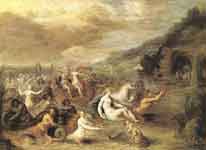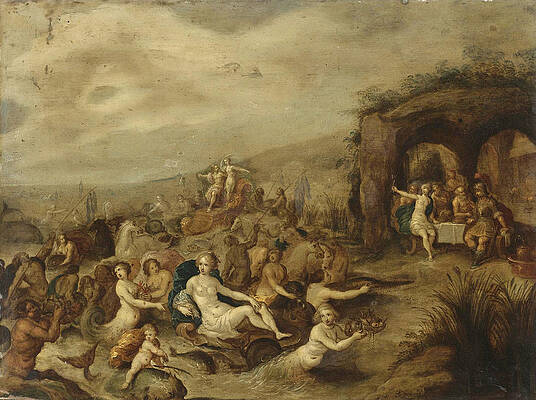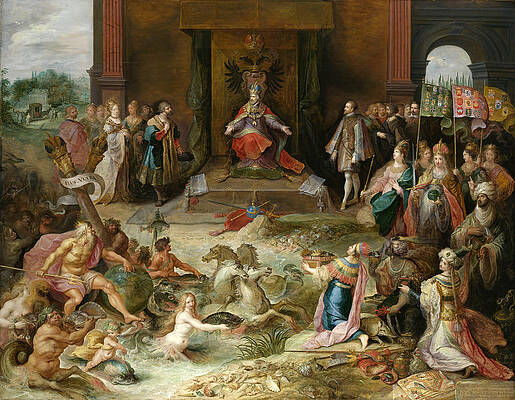Frans Francken the Younger
Paintings
Death playing the Violin
Witches Assembly
Witches' Kitchen
The Penitent Mary Magdalene visited by the Seven Deadly Sins
The Marriage Feast at Cana
The Triumph of Neptune and Amphitrite
The Virgin and Child surrounded by Music-making Angels the Holy Spirit and God the Father above
The Interior of a Picture Gallery with Connoisseurs admiring Paintings
The Crucifixion of St Andrew
Allegory on the Abdication of Emperor Charles V in Brussels
A visit to the Art Dealer
Croesus showing his Treasures to Solon
Man Having to Choose between the Virtues and Vices

Frans Francken the Younger (Antwerp, 1581 – Antwerp, 6 May 1642) was a Flemish painter and the best-known member of the large Francken family of artists. He played an important role in the development of Flemish art in the first half of the 17th century through his innovations in genre painting and introduction of new subject matter. Francken was born in Antwerp where he trained with his father Frans Francken the Elder. He may also have trained with his uncle Hieronymus Francken I in Paris, together with his brother Hieronymus Francken II. He became a master in the Antwerp Guild of Saint Luke in 1605 and was deacon of the Guild in 1616. Francken was very successful and operated a large workshop which made many copies of his original compositions.
His pupils included Daniel Hagens (1616/17), the Monogrammist N.F., his brother Hieronymus II and his son Frans III
Work
General
Frans Francken the Younger was a versatile artist who practised in many genres and introduced new subjects into Flemish art. Many of his works are small historical, allegorical and biblical cabinet paintings with the focus on figures. He also invented or popularized several new themes that became popular in Flemish painting, such as genre scenes populated by monkeys (also referred to as singeries) and Kunstkammer or gallery paintings displaying a wealth of natural and artistic treasures against a neutral wall. Frans Francken the Younger introduced many other unusual themes that later became popular, such as the 'Triumphal Procession of Amphitrite' and 'Croesus and Solon'.[2] Francken also made a series of paintings depicting witches and witchcraft, including portrayals of witches' sabbats.[4]
Frans Francken the Younger signed his works with 'de jonge Frans Francken' ('the young Frans Francken') before the death of his father in 1616. From the late 1620s he used the signature 'de oude Fr. Francken' ('the old Fr. Francken').[5]
His paintings are held by most major museums in Europe.[2]
Allegorical paintings
A large portion of the output of Frans Francken the Younger consisted of allegorical paintings. An example is the Allegory on the Abdication of Emperor Charles V in Brussels (Rijksmuseum). The composition is an allegorical representation of the abdication of Emperor Charles V in Brussels. Charles V who is dividing his empire after a life of continuous warfare and ill health is seated on his thrown flanked by his successors Ferdinand I and Philip II. In front of Philip the personifications of the territories of the Empire with their banners are kneeling down. In the foreground the personifications of the continents America, Africa, Europe and Asia are offering gifts. On the left Neptune is riding his seahorse-drawn triumphal chariot, accompanied by mermen, mermaids and tritons. On the chariot are visible a globe and the two columns with a banderole inscribed with Plus Ultra.[6]
Another allegorical painting is the composition Mankind's Eternal Dilemma: The Choice Between Virtue and Vice (on loan to the Museum of Fine Arts, Boston. It is believed to have been painted at the occasion of a wedding and mixes mythological and Christian symbolism. It represents the eternal choice of mankind between virtue and vice and depicts the three regions of heaven, earth and hell.[7]
Singeries
Frans Francken contributed to the development of the genre of the 'monkey scene', also called 'singerie' (a word, which in French means a 'comical grimace, behaviour or trick').[8] Comical scenes with monkeys appearing in human attire and a human environment are a pictorial genre that was initiated in Flemish painting in the 16th century and was subsequently further developed in the 17th century. The Flemish engraver Pieter van der Borcht introduced the singerie as an independent theme around 1575 in a series of prints, which are strongly embedded in the artistic tradition of Pieter Bruegel the Elder. These prints were widely disseminated and the theme was then picked up by other Flemish artists. The first one to do so was Frans Francken the Younger who played an important role in the development of the genre. Other Antwerp artists subsequently contributing to the genre were Jan Brueghel the Elder and the Younger, Sebastiaen Vrancx and Jan van Kessel the Elder. David Teniers the Younger became the principal practitioner of the genre and developed it further with his younger brother Abraham Teniers. Later in the 17th century Nicolaes van Verendael started to paint these ‘monkey scenes’ as well.[9]
Gallery paintings
Kunstkammer
Frans Francken the Younger and Jan Brueghel the Elder were the first artists to create paintings of art and curiosity collections in the 1620s.[10] Gallery paintings depict large rooms in which many paintings and other precious items are displayed in elegant surroundings. The earliest works in this genre depicted art objects together with other items such as scientific instruments or peculiar natural specimens. Some gallery paintings include portraits of the owners or collectors of the art objects or artists at work. The paintings are heavy with symbolism and allegory and are a reflection of the intellectual preoccupations of the age, including the cultivation of personal virtue and the importance of connoisseurship.[11] The genre became immediately quite popular and was followed by other artists such as Jan Brueghel the Younger, Cornelis de Baellieur, Hans Jordaens, David Teniers the Younger, Gillis van Tilborch and Hieronymus Janssens.
Collaborations
As Francken was particularly skilled in painting the human figure, he frequently collaborated with other artists, such as the landscape artists Tobias Verhaecht, Abraham Govaerts and Joos de Momper, the architectural painters Pieter Neeffs the Elder, Pieter Neeffs the Younger, Hendrik van Steenwijk I, Paul Vredeman de Vries and Bartholomeus van Bassen and flower painters such as Jan Brueghel the Elder and Andries Daniels.[2]
Garland paintings
Crucifixion with Scenes of the Martyrdom of the Apostles
Francken often collaborated with Andries Daniels and Jan Brueghel the Elder and Younger in the production of garland paintings. Garland paintings are a special type of still life developed in Antwerp by artists such as Jan Brueghel the Elder, Hendrick van Balen, Andries Daniels, Peter Paul Rubens and Daniel Seghers. They typically show a flower garland around a devotional image or portrait. This genre was inspired by the cult of veneration and devotion to Mary prevalent at the Habsburg court (then the rulers over the Southern Netherlands) and in Antwerp generally.
Garland paintings were usually collaborations between a still life and a figure painter. Together with Andries Daniels, Frans Francken further developed the genre of garland paintings, creating many special forms, among them garlands around medallions with the decades of the rosary.[10]
Religious works
Later in his life Francken also painted large altarpieces. Among his religiously themed works of particular note are the unusual and stylistically 'reactionary' paintings of biblical scenes, which are framed on all sides by smaller scenes in grisaille. The grisaille frame echoes the Renaissance ecclesiastical portal. Each grisaille scene has its own naturalistic perspective and as a result the compositions provide an odd mixture of three-dimensional naturalism and archaic flatness. An example is the Crucifixion With Scenes of Martyrdom of the Apostles (Dayton Art Institute). Francken used this archaizing technique into the 1620s.[12] This style was possibly invented in the 16th century by the Flemish painter Gillis Mostaert and some works of Mostaert in this style have been erroneously attributed to Frans Francken.[13]
Family tree
Notes
The Virgin and Child with Scenes from the Life of Christ
Frans Francken (II) at the Netherlands Institute for Art History (Dutch)
Ursula Härting. "Francken." Grove Art Online. Oxford Art Online. Oxford University Press. Web. 27 Feb. 2014
Frans Francken II, Witches' Sabbath at the Victoria and Albert Museum
Thomas Christensen, 1616: The World in Motion, Counterpoint Press, 2012, p. 234
Franks Francken III, in: Walter A. Liedtke, Flemish Paintings in the Metropolitan Museum of Art, Metropolitan Museum of Art, New York, 1984, p. 98
Allegory on the Abdication of Emperor Charles V in Brussels at the Rijksmuseum (Dutch)
Sensationsergebnis im Dorotheum - Weltrekord mit 7,02 Mio Euro für Frans Francken II bei der Auktion Alte Meister, Teuerstes jemals in Österreich versteigertes Gemälde at Dorotheum (German)
'Singerie' in Larousse online (French)
Bert Schepers, Monkey Madness in Seventeenth-Century Antwerp, in: The Rubenianum Quarterly, 2012 2, p. 5
Susan Merriam, Seventeenth-Century Flemish Garland Paintings. Still Life, Vision and the Devotional Image, Ashgate Publishing, Ltd., 2012
Marr, Alexander (2010) 'The Flemish 'Pictures of Collections' Genre: An Overview', Intellectual HistoryReview, 20: 1, 5 — 25
Martha Hollander, An Entrance for the Eyes: Space and Meaning in Seventeenth-century Dutch Art, University of California Press, 2002, p. 35.
Carl Van de Velde and James Snyder. "Mostaert: (2) Gillis Mostaert", Grove Art Online. Oxford Art Online. Oxford University Press. Web. 23 Mar. 2015
Further reading
Vlieghe, Hans (1998). Flemish Art and Architecture, 1585-1700. Pelican history of art. New Haven: Yale University Press. ISBN 0-300-07038-1
Liedtke , Walter A. (1984). Flemish paintings in the Metropolitan Museum of Art. New York: The Metropolitan Museum of Art. ISBN 0870993569. (see index).
----
Fine Art Prints | Greeting Cards | Phone Cases | Lifestyle | Face Masks | Men's , Women' Apparel | Home Decor | jigsaw puzzles | Notebooks | Tapestries | ...
----
Artist
A - B - C - D - E - F - G - H - I - J - K - L - M -
N - O - P - Q - R - S - T - U - V - W - X - Y - Z
Retrieved from "http://en.wikipedia.org/"
All text is available under the terms of the GNU Free Documentation License
















